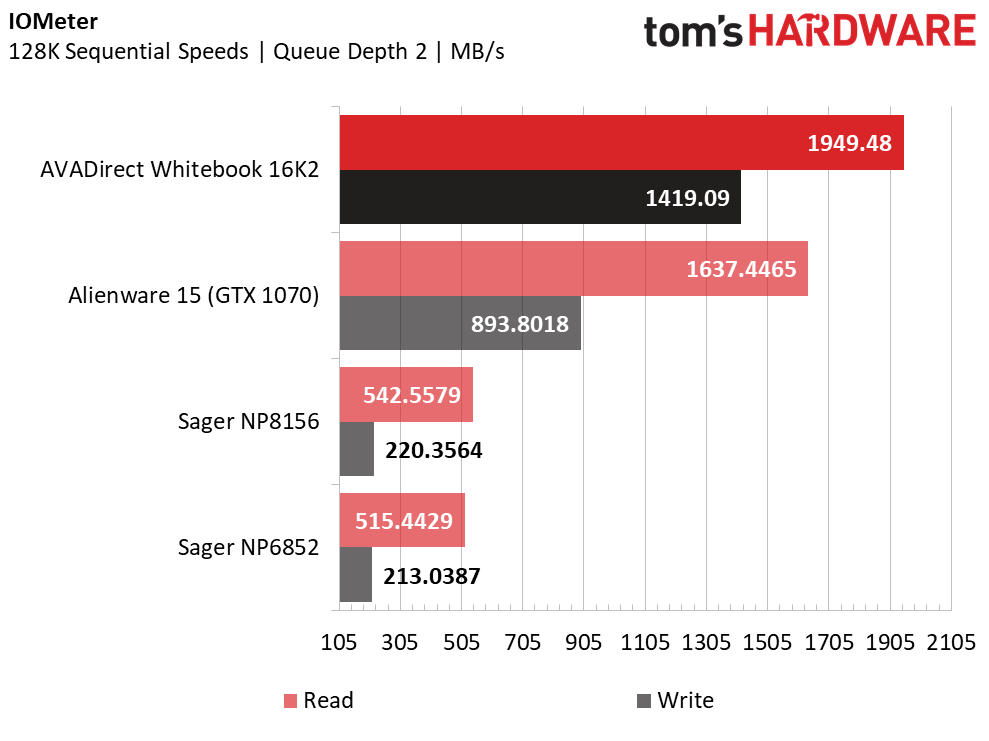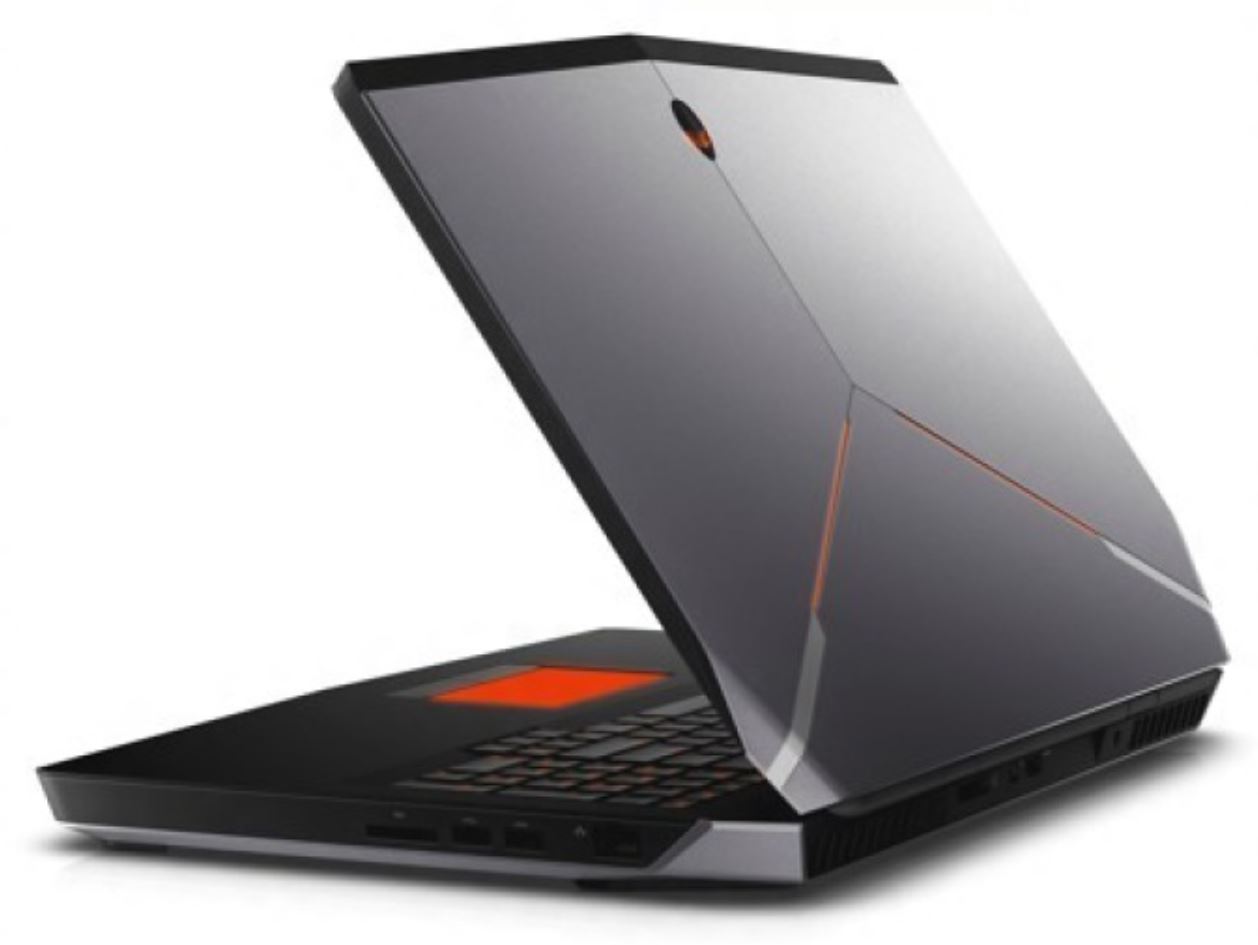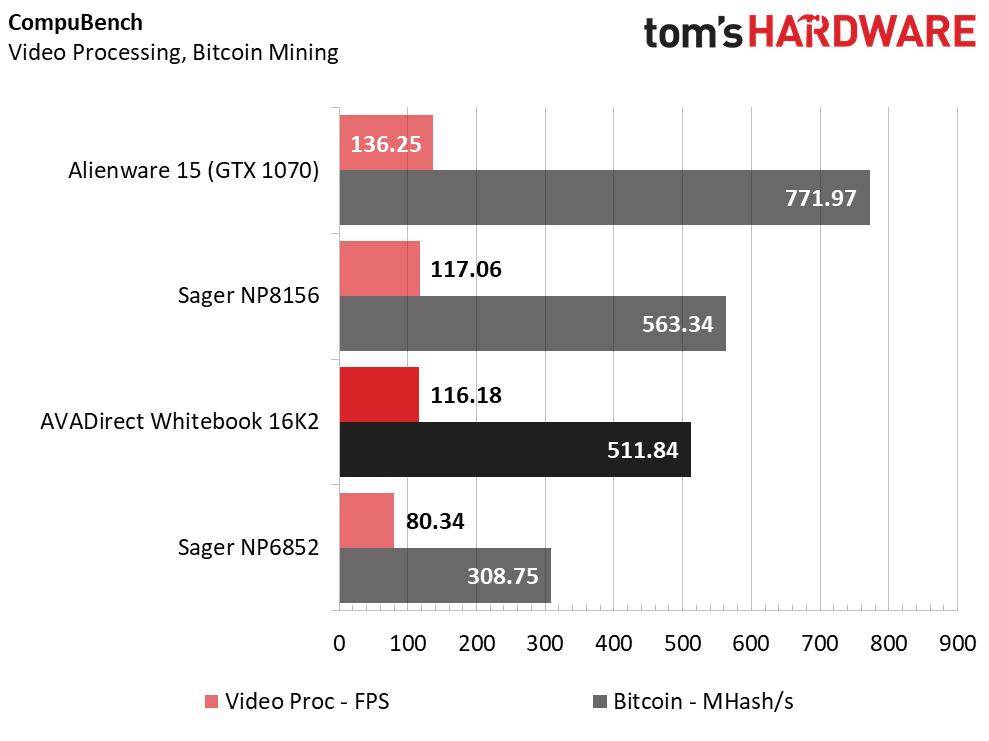AVADirect Whitebook 16K2 Gaming Laptop Review
Why you can trust Tom's Hardware
Synthetic Benchmarks
The AVADirect Whitebook 16K2 has all of the features you might expect from a thin-and-light laptop. It’s packing Intel’s 7th-generation Core i7-7700HQ processor, an Nvidia GeForce GTX 1060, and 16GB of DDR4-2400 memory, while storage is handled by a lone 250GB M.2 SSD. The display is a 15.6” Full HD (1920x1080) matte IPS display with a 60Hz refresh rate. In other words, the Whitebook 16K2 is your standard-fare laptop. We chose competitors that fell slightly under and slightly above this configuration.
The Sager NP8165 is a Clevo-based gaming laptop that matches the AVADirect with an i7-7700HQ CPU, a GTX 1060, and 16GB of DDR4-2400 memory. It also relies on a single M.2 SSD, albeit a 256GB one. Similarly, it's got a 15.6” FHD matte IPS display, but with the added bonus of Nvidia G-Sync. The Whitebook 16K2 and NP8156 are almost identical spec-wise.
Next up is the NP6852, yet another Clevo-sourced laptop from Sager. The NP6852 features an i7-7700HQ, 16GB of DDR4-2400 memory, and the same 256GB M.2 SSD found in the NP8156. However, the NP6852 aims at the budget gaming laptop market by using a GTX 1050 Ti GPU. Like the other two competitors, the NP6852 uses a 15.6” FHD matte IPS display, sans G-Sync. We'll see how much performance is sacrificed by using a more affordable GPU.
Finally, we’ve included the recently reviewed Alienware 15. This laptop is a bit more premium with its GTX 1070, but otherwise it's comparable to the other gaming laptops. It features an i7-7700HQ CPU and 16GB of DDR4-2400 memory. But it also includes a 512GB M.2 SSD and a 1TB 7200RPM HDD for additional storage. It also differs in display choice: a 15.6” FHD matte TN display with G-Sync and a 400-nit brightness rating, running at a 120Hz refresh rate.
3DMark



3DMark’s game-like workloads give us a sneak peak of our roundup’s gaming results. Unsurprisingly, the AVADirect Whitebook 16K2 goes toe-to-toe with the like-minded Sager NP8165 thanks to their GTX 1060 GPUs, with the latter holding a slight edge. Neither comes quite close to besting the much more robust Alienware 15, but their physics scores are remarkably similar by virtue of the shared Core i7-7700HQ (Sager NP6852 included.)
Cinebench R15
Cinebench single core and multi-core results are determined by each laptop’s CPU, and because they’re all using i7-7700HQs, the differences are negligible. However, OpenGL shading is more platform-based, with a slight emphasis on GPU power. The Alienware outperforms both the Whitebook 16K2 and NP8156, but only by a small margin. Comparatively, the NP6852’s GTX 1050 Ti delivers a significantly lower shading score.
CompuBench
CompuBench features a handful of benchmarks; we chose the platform-based Video Processing test and GPU-based Bitcoin Mining test. In Video Processing, the Whitebook 16K2 and NP8156 score evenly. The Alienware gains a 17% performance boost thanks to the GTX 1070, whereas the GTX 1050 Ti lands the NP6852 31% lower than the AVADirect offering. However, the Alienware laptop outperforms the AVADirect unit significantly in Bitcoin Mining, with a 51% lead, while the NP6852 trails by 40%. Interestingly, the NP8156 performs 10% better than the AVADirect laptop in Bitcoin Mining.
Get Tom's Hardware's best news and in-depth reviews, straight to your inbox.
IOMeter


We perform an IOmeter test on each laptop’s primary drive to measure basic random and sequential read and write speeds. The Whitebook 16K2 utilizes a 250GB Samsung 960 EVO NVMe SSD, whereas the Alienware 15 contains a 512GB Samsung PM961 NVMe SSD. Both Sager laptops feature Sandisk X400 M.2 SSDs.
The two Samsung SSDs score pretty evenly in random (QD2) performance, so you can expect the Whitebook 16K2 and the Alienware to launch applications at blazing speed. However, the 960 EVO edges out the PM961 in sequential read performance and writes even faster. Still, the Alienware has double the SSD storage capacity on top of its 1TB HDD. Both SSDs run significantly faster than the Sandisk X400s in the Sager laptops.
PCMark 8
We use PCMark 8’s Microsoft Office and Adobe Creative tests to gauge each laptop’s typical workday load. Because all of the featured laptops contain an i7-7700HQ CPU, you can expect similar performance in PCMark’s platform-based workloads. There are a couple of discrepancies, notably in the Alienware 15’s and Sager NP6852’s Office scores, but you won’t experience a difference in real world usage.
MORE: Best Gaming Laptops
MORE: Gaming Laptop Previews
MORE: All Laptop Content
Current page: Synthetic Benchmarks
Prev Page Introduction & Product Tour Next Page Gaming Benchmarks-
webdevsam Is it possible to install your own 2.5 SSD in the space provided? Are the connections present?Reply -
Kursem well, if you really that thight on budget but wan to game, then I suppose you should get Acer Helios 300 (i7-7700HQ, GTX 1060 6GB, 250GB SSD, FHD IPS), which is only $1,050 on AmazonReply -
ledhead11 Nice review. Nice looking laptop. I'll echo the same thing most say about "gaming' laptops, way, way, overpriced. Pretty sure the marketing and visual design people are laughing all the way to the bank on thing like this.Reply
I have to agree with Kursem. Just checked it out and for nearly a $1000 less you'll have pretty much an identical system. It'd take some serious obsession to choose the Whitebook over the Helios. I'd actually recommend that Helios as a good general all-purpose non-4k laptop, pretty solid looking for the price.





